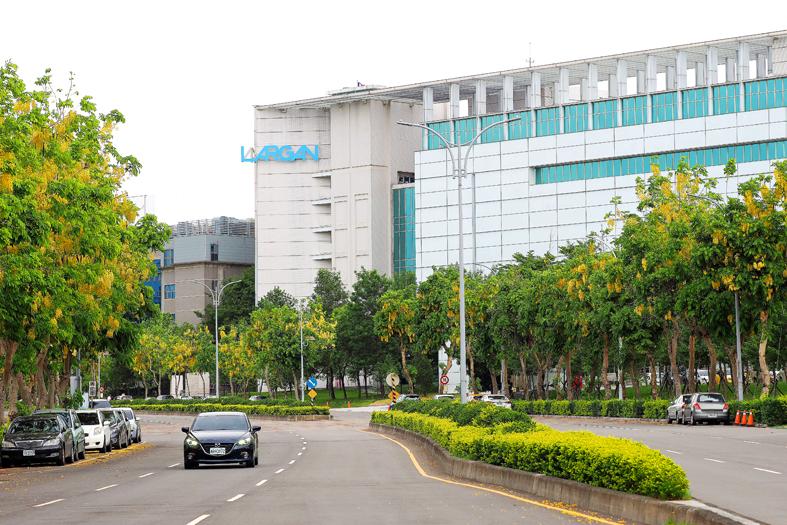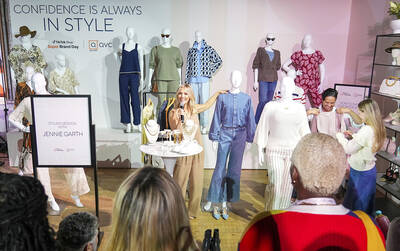Largan Precision Co’s (大立光) gross margin improved in the second quarter of this year thanks to foreign exchange gains and production cost-intensive voice coil motors (VCMs) accounting for a lower share of sales, the smartphone camera lens maker reported yesterday.
Gross margin rose to 55.8 percent, up 2.44 percentage points from 53.36 percent in the first quarter and ending four consecutive quarters of declines, said the leading maker of optical lens modules, which also produces VCMs and sleep monitoring systems.
In the second quarter of last year, gross margin was 60.29 percent, company data showed.

Photo: David Chang, EPA-EFE
Largan did not provide a guidance for gross margin in the second half of the year, as the measure of profitability is subject to multiple factors, including the scale of production, product yield rate, product mix, capacity utilization rate and foreign exchange rate, Largan chief executive officer Adam Lin (林恩平) told an online investors’ conference.
The Taichung-based firm’s net profit was NT$4.95 billion (US$165.6 million) last quarter, down 10.29 percent from a quarter earlier. On a year-on-year basis, profit was up 67.12 percent.
Nonoperating gains contributed NT$2.17 billion, including foreign exchange gains of NT$1.79 billion, Largan said.
As a result, earnings per share were NT$37.06 last quarter, compared with NT$41.3 in the previous quarter and NT$22.7 a year earlier, the company said.
Revenue declined to NT$9.68 billion in the second quarter, down 4.51 percent quarterly and 4.33 percent annually, Largan said, attributing the trend to the COVID-19 lockdowns in China, supply chain snags and consumer market weakness.
Last quarter’s revenue was the lowest since the first quarter of 2018, when sales were NT$8.88 billion, company data showed.
As customers are preparing to launch new smartphones in the fall, the company’s revenue for this month would be higher than last month’s, Lin said, adding that the trend would continue next month.
Largan faces low competition in the high-end mobile phone lens market, and it is to ship 7P and 8P lens modules in the second half of this year, Lin said.
A 7P lens contains seven layers and is more advanced than lenses with fewer layers.
However, demand for such high-end lenses remains weak, as customers are generally less upbeat about the end market amid slowing phone sales worldwide, he said.
Higher inventories could pose another issue for supply chains, he added.
As for the construction of new manufacturing facilities in Taichung, Lin said the new plant is facing a labor shortage.
Therefore it would not start production in the middle of next year as scheduled, he said, adding that the plant would likely provide revenue contribution as early as the fourth quarter of next year.
In the first half of this year, Largan’s revenue totaled NT$19.81 billion, down 10 percent from NT$21.93 billion a year earlier.
It reported net profit of NT$10.46 billion, up 26 percent year-on-year, or earnings per share of NT$78.36, and gross margin of 54.55 percent.

BYPASSING CHINA TARIFFS: In the first five months of this year, Foxconn sent US$4.4bn of iPhones to the US from India, compared with US$3.7bn in the whole of last year Nearly all the iPhones exported by Foxconn Technology Group (富士康科技集團) from India went to the US between March and last month, customs data showed, far above last year’s average of 50 percent and a clear sign of Apple Inc’s efforts to bypass high US tariffs imposed on China. The numbers, being reported by Reuters for the first time, show that Apple has realigned its India exports to almost exclusively serve the US market, when previously the devices were more widely distributed to nations including the Netherlands and the Czech Republic. During March to last month, Foxconn, known as Hon Hai Precision Industry

Taiwan Semiconductor Manufacturing Co (TSMC, 台積電) and the University of Tokyo (UTokyo) yesterday announced the launch of the TSMC-UTokyo Lab to promote advanced semiconductor research, education and talent development. The lab is TSMC’s first laboratory collaboration with a university outside Taiwan, the company said in a statement. The lab would leverage “the extensive knowledge, experience, and creativity” of both institutions, the company said. It is located in the Asano Section of UTokyo’s Hongo, Tokyo, campus and would be managed by UTokyo faculty, guided by directors from UTokyo and TSMC, the company said. TSMC began working with UTokyo in 2019, resulting in 21 research projects,

Ashton Hall’s morning routine involves dunking his head in iced Saratoga Spring Water. For the company that sells the bottled water — Hall’s brand of choice for drinking, brushing his teeth and submerging himself — that is fantastic news. “We’re so thankful to this incredible fitness influencer called Ashton Hall,” Saratoga owner Primo Brands Corp’s CEO Robbert Rietbroek said on an earnings call after Hall’s morning routine video went viral. “He really helped put our brand on the map.” Primo Brands, which was not affiliated with Hall when he made his video, is among the increasing number of companies benefiting from influencer

Quanta Computer Inc (廣達) chairman Barry Lam (林百里) yesterday expressed a downbeat view about the prospects of humanoid robots, given high manufacturing costs and a lack of target customers. Despite rising demand and high expectations for humanoid robots, high research-and-development costs and uncertain profitability remain major concerns, Lam told reporters following the company’s annual shareholders’ meeting in Taoyuan. “Since it seems a bit unworthy to use such high-cost robots to do household chores, I believe robots designed for specific purposes would be more valuable and present a better business opportunity,” Lam said Instead of investing in humanoid robots, Quanta has opted to invest